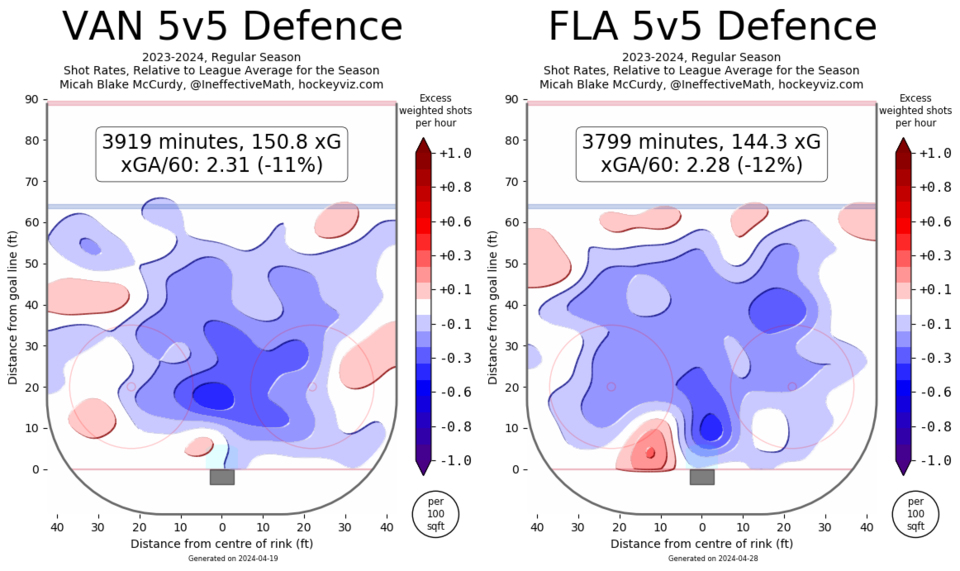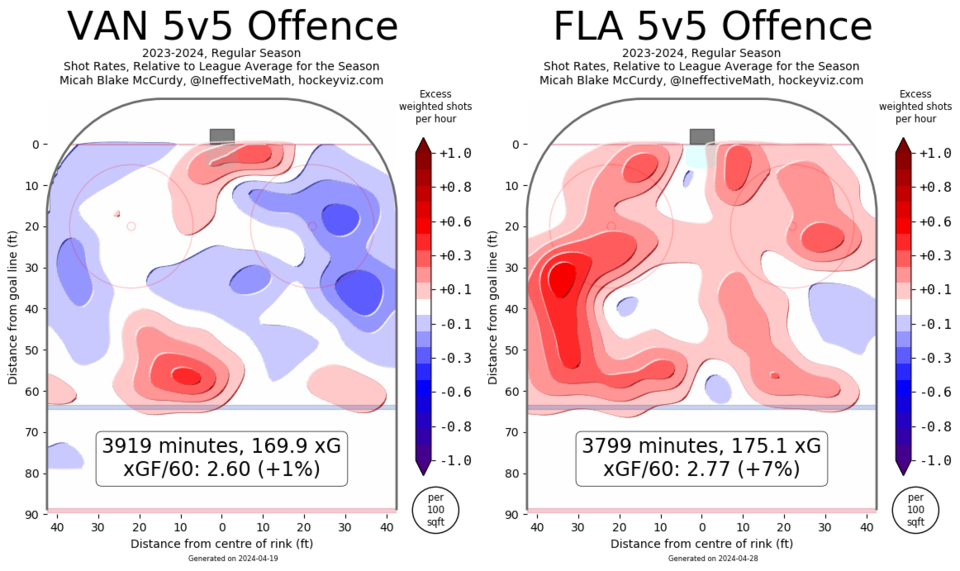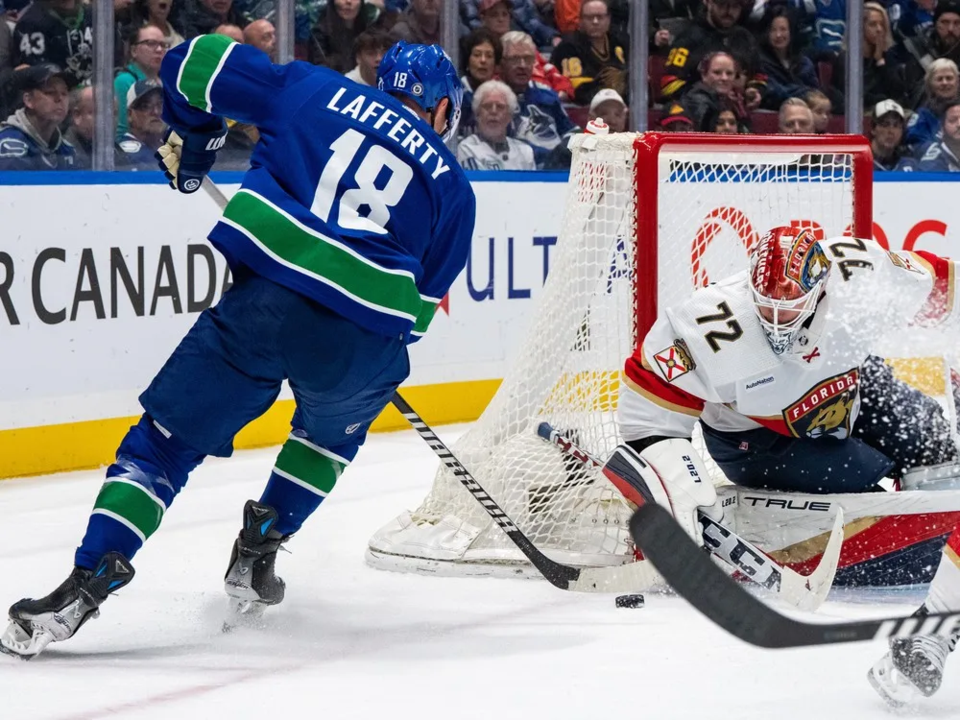The Florida Panthers are one game away from winning the Stanley Cup.
Up 3-0 on the Edmonton Oilers in the Stanley Cup Final, the Panthers could finish off the sweep on Saturday. It has been an incredibly impressive performance top to bottom from the Panthers, as they’ve throttled the Oilers’ high-powered offence while getting scoring throughout their lineup.
From a Vancouver Canucks perspective, it’s perhaps a bummer that another team will win their first Stanley Cup before the Canucks do, but at least a few former Canucks will hoist the Cup, such as Roberto Luongo as part of the team’s front office and Oliver Ekman-Larsson, who is still on the Canucks’ payroll through 2028.
The Panthers have been a powerhouse team for a few years now: they won the Presidents’ Trophy in 2022 and now have back-to-back Stanley Cup Final appearances in 2023 and 2024. This is not an underdog team on a Cinderella run but a team that gradually worked their way into becoming a Cup contender over multiple years.
There’s a lot that can be said about how the Panthers built their roster, such as hitting on high draft picks, putting together blockbuster trades, or making smart waiver claims.
For the moment, however, let’s look at one of the key ways that the Canucks are similar to the Panthers and one of the key ways in which they differ, looking at one of the most basic statistics in hockey: shots.
The Canucks are as defensively sound as the Panthers
Defensively, the Canucks achieved remarkably similar results to the Panthers this past season. Head coach Rick Tocchet instituted a defensive system that effectively protected what he called “the guts” of the ice, limiting both shots from the slot and cross-seam passes, both of which made life a lot easier on their goaltenders.
At 5-on-5, the Panthers were third in the NHL with 53.03 shot attempts against per 60 minutes of ice time. The Canucks were right behind them in fourth with 54.17 shot attempts against per 60 minutes.
Shots on goal were a similar story: the Panthers allowed 26.87 shots on goal against per 60 minutes at 5-on-5, good for sixth in the NHL. The Canucks were slightly better: fourth in the NHL with 26.75 shots against per 60 minutes.
We can see just how similar the Canucks and Panthers were defensively with a heat map from HockeyViz.

The red areas on the heat map are where the two teams allowed an above-average number of shots against; the blue areas are where they allowed a below-average number of shots against. Both teams have lakes of blue in the middle of the ice, with the Panthers slightly better at defending the front of the net than the Canucks.
What separates the Panthers from the Canucks, however, is offence.
The Panthers massively out-shoot the Canucks
Let’s be clear: the Canucks out-scored the Panthers during the regular season. The Canucks were fifth in the NHL in goals at 5-on-5; the Panthers were 26th. During the regular season, the Canucks piled up the goals while the Panthers were among the lowest-scoring teams.
But in terms of how they created offence, the Panthers were far better than their goal totals would suggest and the Canucks were a little bit worse — or at least a little bit more one-dimensional.
The Panthers were second in the NHL in shot attempts at 5-on-5, averaging 66.68 per 60 minutes. The Canucks were 22nd with 57.39 shot attempts per 60 minutes.
In terms of shots on goal at 5-on-5, the Panthers were third in the NHL with 31.98 per 60 minutes; the Canucks were 25th at 26.98.
The difference shows up so clearly on heat maps from HockeyViz.

The Canucks created their shots primarily from the point and directly around the net, which was often tips and rebounds. The Panthers, on the other hand, created excess shots from pretty much everywhere on the ice.
Tocchet: "I've got to do a deep dive."
Canucks fans saw how this translated to the playoffs.
The Canucks averaged 20.8 shots per game in the playoffs, which is the lowest by any NHL team since 2001. That year, the Carolina Hurricanes averaged 19.0 shots per game in a first-round series loss to the New Jersey Devils in which they were shut out twice. That also happened to be square in the middle of the dead puck era, when the neutral zone trap and clutch-and-grab hockey severely limited offence.
Generally speaking, you don’t want to be compared to a team from the dead puck era.
It’s something that Tocchet said he was going to be taking a long look at in the offseason.
“I'd be crazy not to. I've got to do a deep dive,” said Tocchet. “You know, there were some simple things of hitting the net, working on your shot, changing angles — I mean, that's things you've got to work on and it's my job to to make sure these guys keep developing that skill.”
From Tocchet’s perspective, execution was a major issue in the playoffs, as his players repeatedly missed the net or didn’t take advantage of shooting lanes when they opened up. But the heat maps above suggest there could be a systems issue as well.
So much of the Canucks’ in-zone offence was focused on creating point shots with traffic. That’s where the Canucks’ shots came from, largely the left side of the ice at the point, then tips, deflections, and rebounds around the net. Cross-seam passes or plays into the slot were more rare compared to the rest of the NHL.
The issue is, once other teams pick up on that tendency, it’s relatively easy to counter. The Nashville Predators, in particular, countered that tactic by fronting every shot, blocking a ton of shot attempts.
The Panthers, on the other hand, have a far more diverse attack that creates scoring chances all over the ice. That’s a lot harder to gameplan against: you can shut down one facet of the Panthers’ offence but they can quickly shift to another. They’re not reliant on any one method of creating chances.
With their relentless forecheck, the Panthers are also adept at creating second and third chances off the same shift. When they win the puck, they immediately attack, whether at the net, in the slot, or off a cross-seam pass in the faceoff circles.
Tocchet: "Next training camp might be a little bit different."
It’s hard to ignore how shot volume plays a role in the Panthers’ success. While they create a lot of chances from dangerous areas with their cycle game, the Panthers’ game plan, at its most simplified, is to get the puck to the net, win it back, and get it to the net again. They trust in their ability to win battles to prolong possessions so that even a shot from a less dangerous area can be the right play.
Is the Canucks’ system too focused on point shots and not focused enough on getting shots from all over the ice? It’s something to consider.
“There could be some system stuff there. We have some really good hockey minds in that dressing room, the coaching staff, so we'll look at that stuff,” said Tocchet. “I know a lot of people here like shot volume, which I don't mind. I'm not quite sure just throwing the puck at the net with nobody in front — now, we've got to get some guys to get to the net, we need more net-front presence, things like that.”
Tocchet suggested that he’ll be able to address this at training camp ahead of next season now that the team is familiar with what he expects out of them defensively.
“I always feel that, as a coach, you've got to give the players something to look at and maybe going into training camp, maybe it's something we'll work on a little bit more offensively,” said Tocchet. “I think we were heavy system last training camp. I wanted to make sure that guys knew exactly what we needed at certain times and I think we were successful because we did it at training camp.
“I think that next training camp might be a little bit different: a little more creativity, a little more skill-oriented that will help some guys. But good old fashioned we need people to get to the net — we've got to get that in there too.”
Tocchet: "We do have to get better on the rush."
Another aspect of the Panthers’ game that the Canucks could emulate is attacking off the rush. While the Panthers are not exactly a rush team — they were middle of the pack in terms of rush chances during the regular season — they were far more of a rush team than the Canucks, who were nearly last in rush chances.
The Canucks’ lack of rush chances escaped notice a bit during the regular season because they were so good at finishing on the few rush chances they got. But relying solely on finish is a dangerous game.
“It comes from execution and getting your defence in the rush,” said Tocchet. “I love the makeup of our D, it’s big, gangly — you keep McDavid at, what, three assists? That’s hard to do. I credit our D for that. You’ve got to rob Peter to pay Paul sometimes, right?
“Saying that, we do have to get better on the rush and more execution. I think at the start of the year, the first half of the year, we got some good luck. We scored on a 3-on-2, our conversion rate was high. Second half, it wasn’t, and we weren’t getting a lot of 3-on-2s and 4-on-2s. It’s another thing we’ve got to look at, for sure.”
The Canucks’ lack of attack in transition didn’t hurt the Canucks during the regular season but it seemed to be an issue in the playoffs. When you attack off the rush, it puts the other team on their heels and forces them to be more cautious, keeping them from dictating the pace of play. Too often, the Canucks moved up ice with their opponents already back defensively, forcing them to chip and chase to win the puck on the forecheck rather than attacking with possession.
It feels strange to say that a team that one of the top-scoring teams during the regular season needs to work on their offence, but that seems to be the case for the Canucks, at least if they want to get to the Cup-contending level of a team like the Panthers.
The challenge for the Canucks is improving and diversifying their offensive attack without sacrificing their excellent defensive game.




